Institute of Oceanology, Chinese Academy of Sciences
Article Information
- ZHANG Zhishun, JIANG Fuqing, LI Tiegang, YANG Dezhou, ZHOU Xiaojing, XIONG Zhifang, QIU Xiaohua, JIA Qi, YAN Yu, FENG Xuguang
- Sea-level changes controlled detrital sediment inputs to the Bicol Shelf in the western Philippine Sea since 150 ka
- Journal of Oceanology and Limnology, 38(4): 1153-1168
- http://dx.doi.org/10.1007/s00343-020-0051-4
Article History
- Received Jan. 19, 2020
- accepted in principle Mar. 12, 2020
- accepted for publication Apr. 29, 2020
2 Center for Ocean Mega-Science, Chinese Academy of Sciences, Qingdao 266071, China;
3 University of Chinese Academy of Sciences, Beijing 100049, China;
4 Laboratory for Marine Geology, Qingdao National Laboratory for Marine Science and Technology, Qingdao 266237, China;
5 Key Laboratory of Marine Sedimentology and Environmental Geology, First Institute of Oceanography, Ministry of Natural Resources, Qingdao 266061, China;
6 Key Laboratory of Ocean Circulation and Waves, Institute of Oceanology, Chinese Academy of Science, Qingdao 266071, China;
7 School of Marine Science and Environment, Dalian Ocean University, Dalian 116023, China;
8 No. 1 Institute of Geology and Mineral Resources of Shandong Province, Jinan 250014, China;
9 School of Geography and Ocean Science, Nanjing University, Nanjing 210023, China
The western Philippine Sea is a key area of global air-sea and land-ocean interactions and it is also an important location for the exchange of material and energy. Thus, it plays an important role in regional source-to-sink processes and global climate change. The Philippine Islands are typical high-standing islands, with stream headwaters at an elevation of 1 000 m or more above sea level (Milliman and Syvitski, 1992). The coastal mountains have led to the development of short and steep mountain streams. Although the drainage area of the mountain streams is small, they deliver a large amount of suspended material to the Philippine Sea due to the abundant rainfall and the occurrence of strong weathering and erosion (Milliman and Meade, 1983; Milliman and Syvitski, 1992). Several studies of sediment provenance have demonstrated that the siliciclastic detrital sediments (hereafter referred as detrital sediments) supplied from the Philippine Islands are an important component of the sediments of the Philippine deep-sea basin and Benham Rise (Wan et al., 2012; Xu et al., 2012, 2014, 2015; Yu et al., 2012, 2016, 2018; Jiang et al., 2013, 2016; Liu et al., 2016; Zhou et al., 2016). However, the sedimentary characteristics of the Philippine Islands have not been studied systematically. Although several provenance studies in the Bicol Shelf demonstrated that the detrital sediments were mainly derived from the Philippine Islands and Asian dust (Xiong et al., 2018; Xu et al., 2018), we lack a clear understanding of the source of different detrital size fractions, their transport mechanisms, and the controlling factors in the nearshore area of the Philippine Islands.
The grain-size composition of marine sediments provides information about the characteristics of the sediment source area and the processes of transport and sedimentation, and therefore grain-size fractions are important paleoenvironmental proxies. Due to the influence of a variety of provenances and dynamic processes, sediment grain-size parameters (e.g. mean grain size) can provide comprehensive information about the depositional environment. However, the separation of individual grain-size components from a multi-modal grain-size distribution in order to explore the paleoenvironmental implications of each component remains problematic (Sun et al., 2003). In recent years, several methods have been explored to separate different grain-size end members; they include fitting the Weibull function to grain-size distributions (Sun et al., 2002), end-member modeling (Jan Weltje, 1997), grain-size-standard deviations (Boulay et al., 2003), principal components analysis (Chen et al., 2008), and parametric end-member analysis (Paterson and Heslop, 2015). Parametric end-member analysis combines the advantages of the function curve-fitting method and non-parametric end-member model analysis, and it can fit an entire multi-sample data set by end-members with preset parameters (Paterson and Heslop, 2015). The method avoids technical problems such as contingency and randomness caused by the function curve-fitting method that can only decompose a single sample, and it solves the problem of the end members obtained by non-parametric decomposition being multimodal, with some end members even spanning the entire grain-size range (Li et al., 2018). Using this method, a multimodal grain-size distribution curve can be inverted to unimodal end-members, and the relative contributions of each end member can be quantitatively estimated.
In this study, we analyzed the grain-size compositions of detrital sediments of a sediment core from the Bicol Shelf in the western Philippine Sea, and then quantitatively separated different grain-size end-members using an improved parametric end-member analysis method (Paterson and Heslop, 2015). We also measured the radiogenic Sr and Nd isotopic compositions of different end members in order to determine their transport mechanisms. Finally, we used the results to discuss the major factors controlling the supply of detrital sediments to the Bicol Shelf.
2 REGIONAL GEOLOGICAL SETTINGThe Philippine Islands comprise more than 7 100 islands. The southern islands are connected to the Indonesian Islands, and the northern islands to the Japanese archipelago via Taiwan, China. The Philippine Islands are characterized by strong subduction, a well-developed strike-slip fault, and frequent earthquakes and volcanic activity; this is because they are located in the collision zone of the Eurasian Plate, the Philippine Sea Plate and the Indo-Australian Plate (Mukasa et al., 1994; Aurelio, 2000; Ma et al., 2018). Luzon Island, the largest island, is located in the northern part of the Philippine Islands; it has a relatively high terrain in the north and low terrain in the south. The mountains of Luzon Island are distributed along the coast with a north-south orientation (Fig. 1). The predominant lithologies are Cretaceous to Quaternary sedimentary and extrusive rocks, with Cenozoic intermediate intrusive rocks common throughout the islands. The sedimentary rocks usually contain andesitic-basaltic pyroclastics and lavas. Cretaceous-Paleogene volcanic rocks are distributed in most of the mountainous regions of Luzon. Plio-Quaternary volcanic deposits occur mainly in southern Luzon, principally andesites and basalts with associated dacites and rhyodacites. Mesozoic ultrabasics, mainly peridotite, dunite, and layered gabbro, occur in the eastern and southwestern margins of Luzon. An area of Paleozoic metamorphic rocks is also developed in the eastern margin (Liu et al., 2009). The northern part of the east Luzon shelf is narrow and steep, and the southern part is wider and flatter. This wider region is called the Bicol Shelf, and consists of a shallower, more landward portion in water depths < 200 m and a deeper fringe which in the north resembles a terrace in water depths of ~500– 800 m. Beyond this fringing 'step' in the bathymetric profile, a steep slope descends to the northern end of the Philippine Trench (Fig. 1). The average detrital mass accumulation rate (MAR) in the Bicol Shelf is ~9.2 g/(cm2∙ka) (Xiong et al., 2018; Xu et al., 2018), which is significantly higher than that in Benham Rise (~1.5–2.1 g/(cm2∙ka), Yu et al., 2012; Jiang et al., 2016).
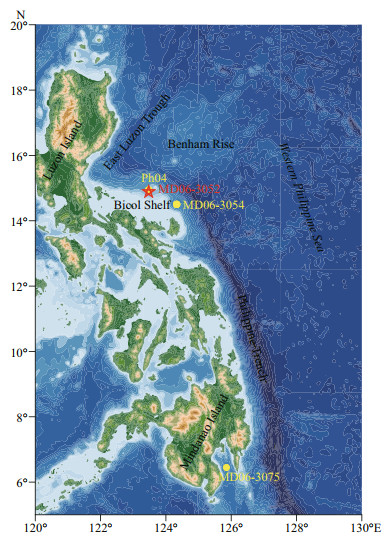
|
| Fig.1 Locations of core MD06-3052 and other sediment cores published Ph04 (after Jiang et al., 2013), MD06-3054 (after Xiong et al., 2018), and MD06-3075 (after Fraser et al., 2014). |
The Philippine Islands are warm throughout the year, with the highest temperatures in spring (26– 27℃), and the lowest in winter (23–24℃) (Xiong et al., 2018). There are significant seasonal variations in precipitation due to the influence of the seasonal meridional migration of the intertropical convergence zone (ITCZ). In the boreal winter, the ITCZ moves southward to the Equator, while the Philippine Islands are located at the northern boundary of the range of migration of the ITCZ migration and therefore precipitation is lower (Xiong et al., 2018). In contrast, during the boreal summer, the ITCZ moves northward close to Luzon Island, and precipitation increases in the area (Jia et al., 2018; Xiong et al., 2018). In addition, observation data show that the interannual variation of precipitation in the studied area is significantly affected by El Niño-Southern Oscillation (ENSO). Precipitation decreases during the El Niño phase and increases during the La Niña phase (Jia et al., 2018; Xiong et al., 2018).
The surface currents in the western Philippine Sea are dominated by the North Equatorial Current (NEC). When the NEC which flows from east to west reaches the coast of the Philippine Islands, it is bifurcated by the topography to form the north-flowing Kuroshio Current and the south-flowing Mindanao Current (Fine et al., 1994; Xie et al., 2009). In this study, based on the ROMS (Regional Ocean Modelling System) model (Shchepetkin and McWilliams, 2005), we performed a high-resolution numerical simulation of the current field along the eastern coast of the Philippine Islands (see Yang et al. (2018) for details). The simulation results show that the ocean currents in the area exhibit pronounced seasonal variations (Fig. 2). In winter, the NEC bifurcates at ~12°N, while in summer, the bifurcation point moves north to ~14°N; in addition, the velocity of the Kuroshio Current decreases compared to that in winter. This is consistent with the results of several other simulation studies and observations (Qiu and Lukas, 1996; Qu and Lukas, 2003; Kim et al., 2004). There are relatively few studies of the near-shore bottom currents in the studied area. Our simulation results show that the velocity of the bottom currents is less than that of the surface currents. It is similar to the surface currents in winter, with a bifurcation at ~12°N; one branch flows northward and the other flows southward. In summer, the pattern is significantly different from the surface currents. There is only a single coastal bottom current from north to south, and it is significantly enhanced compared to bottom currents in winter (Fig. 2).
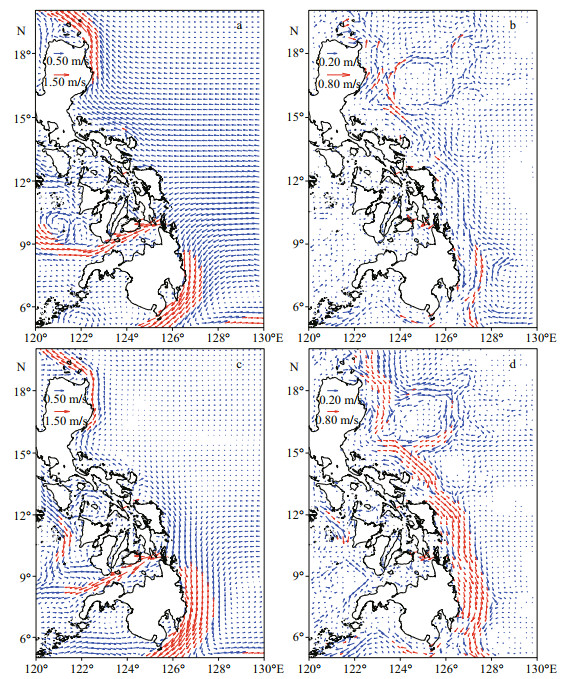
|
| Fig.2 Modeled surface (a, c) and bottom (b, d) current fields in the Philippines Sea in different seasons a & b. monthly mean ocean currents on February; c & d. monthly mean ocean currents on August. |
Core MD06-3052 was retrieved with a Calypso Giant Piston Corer onboard R/V Marion Dufresne during the IMAGES XIVMD155-Marco Polo 2 cruise in June 2006 (Laj et al., 2006). The coring site was located on the deeper outer fringe of the Bicol Shelf (14°48.604 2′N, 123°29.398 3′E), ~200 km offshore from the eastern coast of Luzon, Philippines (Fig. 1), in a water depth of 732 m. The total core length is 19.48 m. The core sediments are mainly composed of olive-gray to gray silty clay and clay silt, with abundant foraminifera and nannofossils in some layers. The carbonate content (dominated by biogenic carbonate) ranges from 13.8% to 73.6% (Xu et al., 2018). The sediment profile contains six turbidite layers and four discrete tephra layers (Laj et al., 2006; Qiu, 2013). Qiu (2013) established a preliminary chronological framework for core MD06-3052, based on three AMS 14C dates and the oxygen isotope composition of planktonic foraminifera (Globigerinoides ruber). The chronological framework was refined based on the lithological and grain-size composition with the removal of turbidites and tephra layers (Fig. 3). Nine age-control points were obtained by comparing the oxygen isotope record of G. ruber in core MD06-3052 with the LR04 oxygen isotope stack (Lisiecki and Raymo, 2005) (Fig. 3), together with three AMS 14C dates (Qiu, 2013). The age model was constructed using linear interpolation and it indicates that core MD06-3052 records the depositional history of the Bicol Shelf since 150 ka.
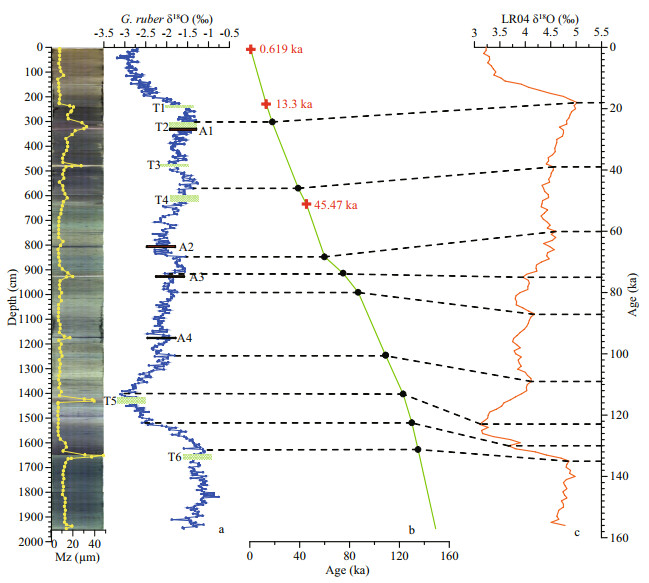
|
| Fig.3 Core photo, grain-size record and chronological framework of core MD06-3052 a. oxygen isotopic composition of G. ruber; b. age-depth model (Qiu, 2013); c. LR04 δ18O stack (Lisiecki and Raymo, 2005). T1–T6 are six turbidite layers and A1–A4 are four tephra layers. The red crosses indicate the locations of calibrated AMS 14C dates and the black dots are age control points obtained by comparison of the δ18O records of core MD06-3052 with the LR04 stack. |
The core was sub-sampled at 16 cm intervals and a total of 139 samples (including 121 normal marine sediments (detrital muds), 15 turbidites and 3 tephras) were prepared for grain-size analysis. In order to extract the detrital components, ~300 mg of each bulk sediment sample was treated with distilled water, acetic acid (10%, 10 mL, shaken overnight at 125 r/min), hydroxylamine hydrochloride (0.05 mol/L, 10 mL, shaken overnight at 125 r/min), NaOH (1 mol/L, 10 mL, shaken overnight at 125 r/min), and hydrogen peroxide (5%, 10 mL, shaken overnight at 125 r/min) at room temperature to remove sea salts, carbonates, ferromanganese coatings, opal and organic matter, respectively (Bayon et al., 2002; Gutjahr et al., 2007; Jiang et al., 2013). After the leaching procedure, the resulting detritus was dispersed with 0.05 mol/L sodium hexametaphosphate [Na6(PO 3)6]. The grain-size composition of the samples was measured using a Cilas-1190L laser grain-size analyzer at the Key Laboratory of Marine Geology and Environment of the Institute of Oceanology, Chinese Academy of Sciences. The grain-size analyzer has an analytical range of 0.01 to 2 500 μm and the relative error for repeated measurements is less than 2%.
According to the grain-size compositions and frequency distributions of the siliciclastic detrital sediments, seven samples from glacial and interglacial periods (2 g for each sample, Table 1) were collected to extract detrital components using the above-mentioned leaching procedure. The > 20 μm fraction was separated by wet sieving and the < 4 μm detrital component was separated by centrifugation. After drying and grinding, the Sr and Nd isotopic compositions of the two grain-size fractions were measured in the Oceanic Lithosphere and Mantle Dynamics Laboratory of the Institute of Oceanography, Chinese Academy of Sciences. About 50 mg of each sample was weighed and completely dissolved in concentrated HNO3 and HF, and then separated and purified with ion exchange resin to obtain elemental Sr and Nd, respectively. 87Sr/86Sr and 143Nd/144Nd ratios were determined using a Nu Plasma Ⅱ type multi-receiving inductively coupled plasma mass spectrometer (MC-ICP-MS). During the measurements, calibration was performed with 86Sr/88Sr=0.119 4, 146Nd/144Nd=0.721 9. The average test value of the NBS-987 standard was 87Sr/86Sr=0.710 174±9 (n=21, 2SD), and the average test value of the JNdi-1 standard was 143Nd/144Nd= 0.512 116±9 (n=15, 2SD). The Nd isotope data are expressed as εNd (0)=[(143Nd/144Ndsample)/(143Nd/144NdCHUR)–1] ×10 000;143Nd/144NdCHUR is 0.512 683 (Jacobsen and Wasserburg, 1984).

|
Parametric end-member analysis was performed on the grain-size data to separate different end-members. This analysis was implemented by simplex optimal estimation, hierarchical alternating least-squares nonnegative matrix factorization (HALS-NMF) and the simplex projection unmixing algorithm. The method first performs non-parametric end-member analysis and identifies non-parametric end-members, and then estimates the parametric end members. Finally, the grain-size distribution of a series of samples can be decomposed into a set of single-peak parametric end-elements (Paterson and Heslop, 2015).
The MAR (g/(cm2∙ka)) of detrital sediments was calculated as: MAR=Wt%×LSR×DBD, where Wt % is the content of detritus, LSR is the linear sedimentation rate (cm/ka), and DBD is the dry bulk density (g/cm3) which is obtained from drying and weighing a known volume of bulk sediment sample. Other researchers have documented expanded thicknesses of recovered sediment in the upper portions of Calypso cores, up to twice the true stratigraphic thicknesses in extreme cases, in water depths of 2 000–3 000 m (Skinner and McCave, 2003; Széréméta et al., 2004). This oversampling is caused by recoil of the coring cable, and results in overestimation of LSR and therefore MAR because bulk density is not seriously affected (Széréméta et al., 2004). In this study, water depth at site MD06-3052 is considerably less (732 m), implying less cable stretching and recoil. For this reason, possible distortion of core dimensions and LSR are expected to be small and so are ignored.
4 RESULT 4.1 Grain-size composition and variation of the detrital sediment fractionThe grain-size frequency distribution of the detrital sediments of core MD06-3052 is basically trimodal (Fig. 4). For the detrital muds (Fig. 4a & b), three grain-size modes, at 3–4 μm, 10–11 μm, and 36– 45 μm, were observed. The grain size ranges 0.5– 140 μm, and the mean grain-size ranges 6.4–22.6 μm, in average of 10.2 μm; the median grain size ranges 7.2–32.3 μm, in average of 10.8 μm (Fig. 5). The grain size of the turbidite layer (Fig. 4c) is obviously coarser than the other sediment layers, and the grain size ranges 0.5–250 μm, with three modes at 3–4 μm, 10– 11 μm, and 63–85 μm, respectively. The grain-size range of the tephra (0.5–140 μm, Fig. 4d) is similar to that of the detrital mud but with different modal grain sizes, at 12–14 μm, and 36–45 μm.
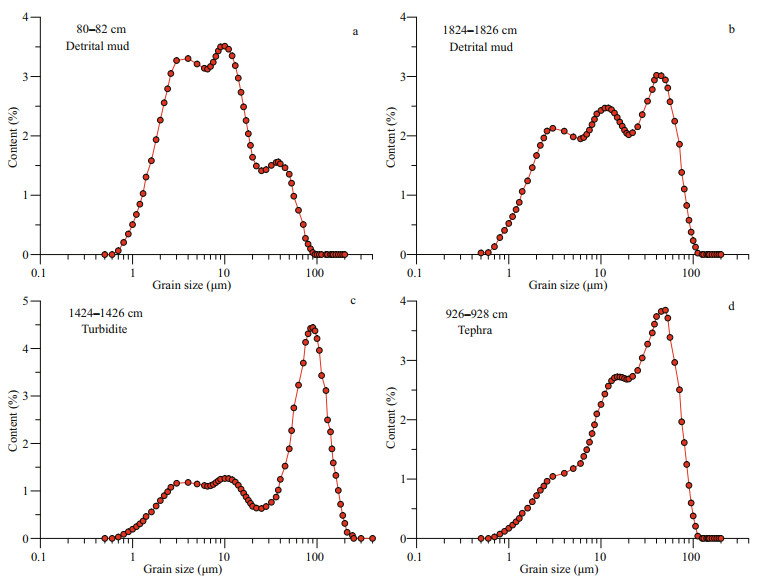
|
| Fig.4 Grain-size frequency distributions of siliciclastic detrital sediments in typical sedimentary layers of core MD06-3052 |
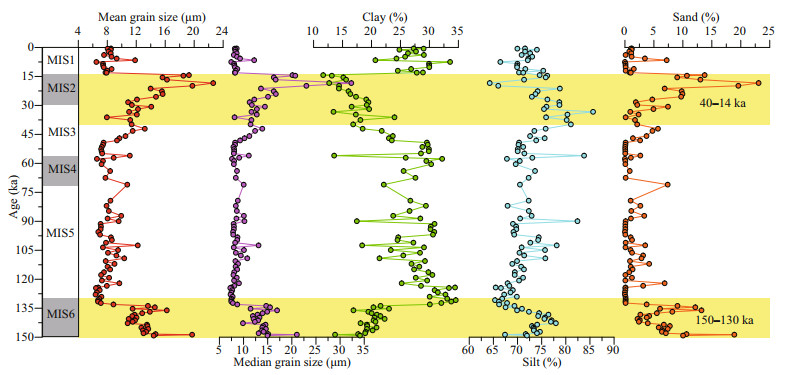
|
| Fig.5 Mean grain size, median grain size, and grain-size composition of detrital muds (excluding turbidites and tephras) in core MD06-3052 The yellow shaded area in the figure represents the two time periods of 150-130 ka and 40-14 ka. |
The detrital muds (excluding turbidites and tephras) in core MD06-3052 are mainly composed of silt and clay, with a minor sand component (Fig. 5). The contents of clay, silt, and sand vary from 11.7% to 34.5%, from 64.2% to 85.6%, and from 0 to 23.1%, with averages of 24.2%, 72.3%, and 3.5%, respectively. The contents of silt and sand were significantly higher during the two glacial periods (150–130 ka, 40–14 ka). The clay content generally shows the opposite trend to that of the silt and sand. The mean grain size and median grain size increased during the two glacial periods (150–130 ka, 40– 14 ka), corresponding to increased silt and sand content (Fig. 5).
4.2 Content and MAR of different grain-size end membersThe grain-size composition of the detrital muds was quantitatively separated using parametric end-member analysis with the General Weibull function (Fig. 6). The number of end members was chosen based on the coefficient of determination and the angular deviation. When the coefficient of determination is close to 1, the angular deviation is small, which indicates a good fitting result (Paterson and Heslop, 2015). As the number of end members increases, the coefficient of determination (R2) increases and approaches 1 and the angular deviation gradually decreases (Fig. 6), indicating a better fitting result (Paterson and Heslop, 2015). Considering the relationship between the number of end members and the angular deviation (Li et al., 2018), we chose three end members. In this case, the coefficient of determination (R2) was 0.97 and the angular deviation was 5.97. Therefore, we concluded that the fitting result was good and that an excessive degree of fitting was avoided.
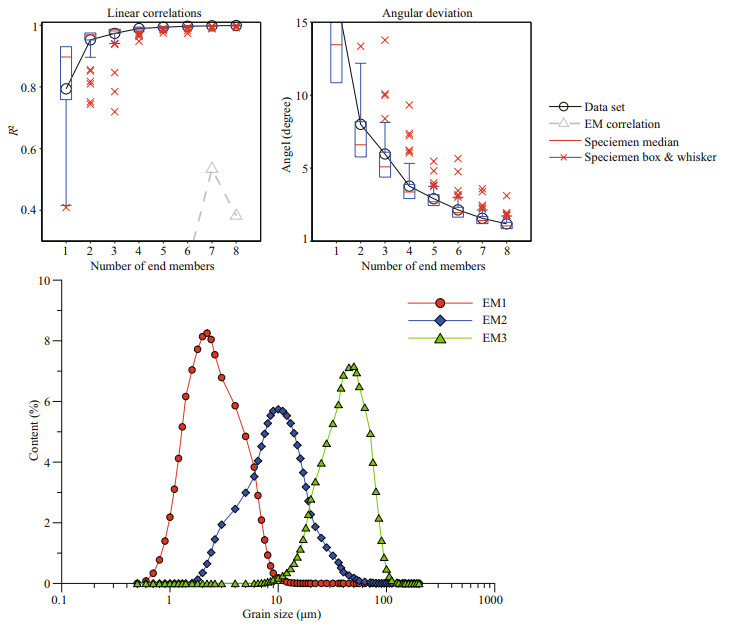
|
| Fig.6 Results of grain-size end-member analysis of the siliciclastic detrital sediments of core MD06-3052 |
The three detrital end members (EM1, EM2 and EM3) obtained from the General Weibull function fitting have modal sizes at ~2, ~10, and ~45 μm, respectively (Fig. 6). The content of EM2 in the bulk sediment is the highest, with an average of 20.9% and a range of 6.0%–47.7%. The average content of EM1 and EM3 in bulk sediment is similar with values of 9.0% and 11.0%, and ranges of 1.5%–17.0% and 0.8%–37.9%, respectively. On the whole, the contents of EM1, EM2 and EM3 and the total detritus exhibit similar trends of variation during the last 150 ka, showing a significantly increased content during the two glacial periods (150–130 ka, 40–14 ka) (Fig. 7).
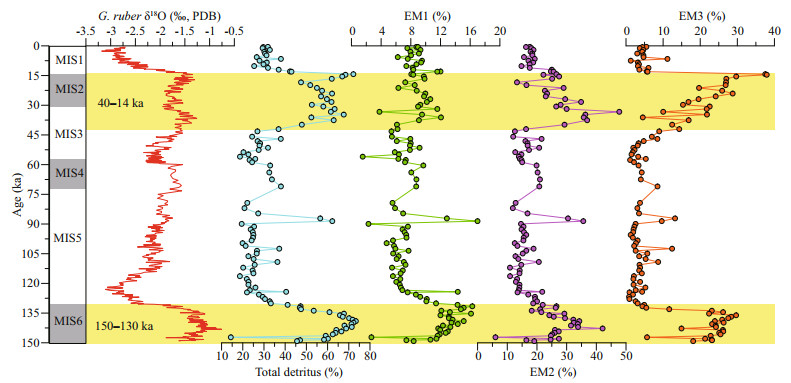
|
| Fig.7 Profiles of total siliciclastic detritus and the three non-carbonate end members found in the bulk sediments of core MD06-3052 The δ18OG.ruber data for core MD06-3052 are cited from Qiu (2013).The yellow shaded area in the figure represents the two time periods of 150-130 ka and 40-14 ka. |
The MAR of total detritus and each end-member component are shown in Fig. 8. The average MARs of the total detritus, EM1, EM2, and EM3 are 6.6, 1.5, 3.3, and 1.8 g/(cm2∙ka), respectively. The MAR of the total detritus and coarse detritus end members (EM2 and EM3) are similar; both were higher during the two glacial periods (150–130 ka, 40–14 ka), while the MARs at other times were relatively low. The MAR of EM1 has similarities and differences compared with the coarse detritus; it was relatively high during 150–130 ka, but relatively low during 40–14 ka. The relatively high ratios of EM1-MAR/(EM2+EM3)-MAR during 130–40 ka, and from 14 ka to the present indicate that the relative contribution of fine detritus increased during these periods.

|
| Fig.8 Profiles of the MAR of total detritus and different end members in the normal marine sediments (excluding turbidites and tephras) of core MD06-3052 The yellow shaded area in the figure represents the two time periods of 150-130 ka and 40-14 ka. |
The Sr and Nd isotope compositions of the fine-grained (< 4 μm) and coarse-grained (> 20 μm) detrital components were measured to trace the source of the different end members (Table 1, Fig. 9). The 87Sr/86Sr ratios of the fine-grained component in core MD06-3052 vary from 0.705 384 to 0.706 790, with an average of 0.706 351, and the εNd (0) values range from 3.5 to 4.5, with an average of 4.1. These characteristics are similar to those of the < 5 μm fine detrital siliciclastic component of nearby core Ph04 (Jiang et al., 2016; Fig. 9). The 87Sr/86Sr ratios of the coarse-grained component of core MD06-3052 vary from 0.703 848 to 0.704 952, with an average of 0.704 285, and the εNd (0) values of the coarse-grained component range from 3.9 to 5.9, with an average of 5.1. The Sr and Nd isotopic composition of the same grain-size components in different layers varies slightly. For the same layer, the Sr and Nd isotope compositions of the fine-grained fraction is more evolved than those of the coarse-grained fraction, which is similar to the record from nearby site Ph04 (Jiang et al., 2016; Fig. 9). The Sr and Nd isotopic compositions of the bulk detritus at downslope site MD06-3054 (Xiong et al., 2018; Fig. 9) are intermediate between those of the two grain-size fractions at site MD06-3052.
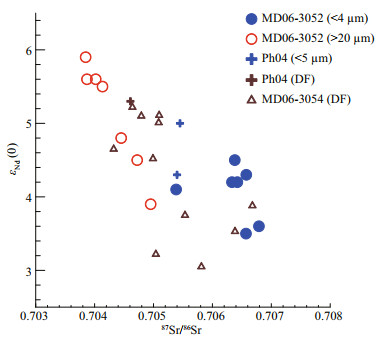
|
| Fig.9 87Sr/86Sr-εNd (0) plot of different grain-size fractions of the detrital sediments of core MD06-3052 compared with adjacent sites in the western Philippine Sea Data sources: Core Ph04 from Jiang et al.(2013, 2016); Core MD06-3054 from Xiong et al. (2018). DF: non-carbonate detrital fraction. |
The radiogenic Sr and Nd isotopic evidence indicates that the bulk detrital sediments of the Bicol Shelf are mainly derived from volcanic materials derived from Luzon Island, with a minor Asian dust component (Xiong et al., 2018; Xu et al., 2018). Clay mineral evidence also indicates that Luzon Island contributes ~96.4% of the clay mineral component of the Bicol Shelf, while the Asian interior only contributes a minor amount of illite (~3.6%) (Chi et al., 2009). Although previous work has addressed the provenance of the detrital sediments, the provenance of different size fractions and different end members had not been investigated. To address the problem, we compared the Sr and Nd isotopes of the < 4 μm fraction and >20 μm fraction with those of potential sources, including volcanic material from the Philippine Islands (Defant et al., 1990; Mukasa et al., 1994), eolian dust from the Asian interior (Sun, 2005; Chen et al., 2007; Wang et al., 2007; Chen and Li, 2013), and Asian dust deposited in the north Central Pacific (representing long-distance transported and homogeneous Asian dust; Pettke et al., 2000) (Fig. 10). The results show that the Sr and Nd isotopic composition of the >20 μm detritus is similar to that of the volcanic rocks of Luzon Island (Defant et al., 1990; Mukasa et al., 1994), but significantly different from that of East Asian desert sand (Chen et al., 2007) and Chinese loess (Sun, 2005; Wang et al., 2007; Chen and Li, 2013), and Asian dust from the central North Pacific (Pettke et al., 2000). We conclude that the >20 μm fraction is mainly derived from Luzon Island, and because the EM3 end-member detritus is mainly composed of detrital sediments coarser than 20 μm, we believe that EM3 is mainly from Luzon Island.
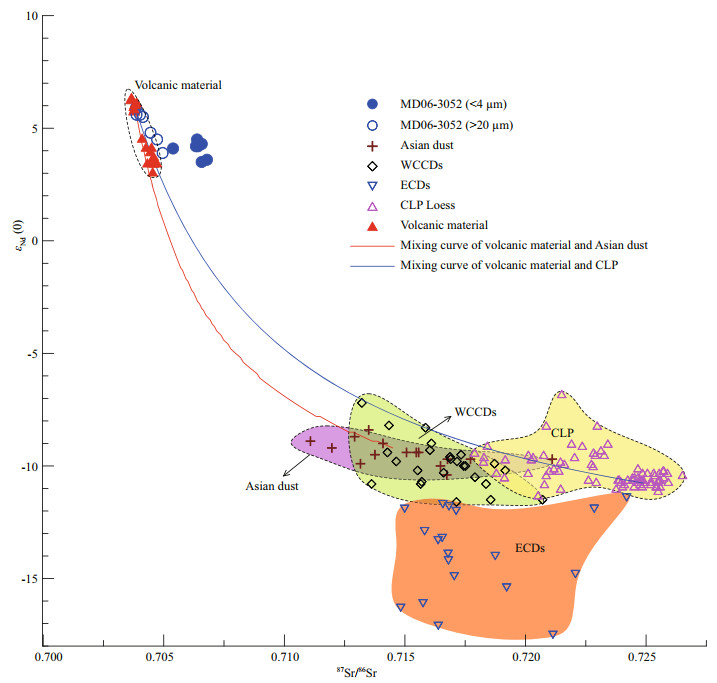
|
| Fig.10 87Sr/86Sr-εNd (0) plot for different grain-size fractions (< 4 and > 20 μm) of the detrital sediments of core MD06-3052 and potential source regions The data from Luzon volcanic material are from Mukasa et al. (1994) and Defant et al. (1990); the data from western and central China's deserts (WCCDs) and eastern China's deserts (ECDs) are from Chen et al. (2007); the data from the Chinese Loess Plateau (CLP) are from Chen and Li (2013), Wang et al. (2007) and Sun (2005); and the data from Asian dust are from Pettke et al. (2000), The red and blue lines are the mixing curves of volcanic material from Luzon Island and average Asian dust (Pettke et al., 2000) and CLP loess (Sun, 2005), respectively. The mixing lines in the 87Sr/86Sr versus εNd (0) plot were developed from known concentrations and isotopic signatures of Sr and Nd. The average volcanic material from the Luzon Islands (Sr=440×10-6, Nd=19×10-6, 87Sr/86Sr=0.703 76, and 143Nd/144Nd=0.512 95) (Defant et al., 1990), CLP loess (Sr=98.7×10-6, Nd=18.8×10-6, 87Sr/86Sr=0.724 882 and 143Nd/144Nd=0.512 086) (Sun, 2005), and Asian dust indicated by sediments of the north Central Pacific (Sr=219.1×10-6, Nd=39.4×10-6, 87Sr/86Sr=0.715 03 and 143Nd/144Nd=0.512 147, n=15) (Pettke et al., 2000). |
The 87Sr/86Sr ratios of the < 4 μm detrital fraction are slightly higher than those of the >20 μm detritus and Luzon Island rocks, but significantly smaller than that of Asian dust (Fig. 10). There are two possible reasons for these increased 87Sr/86Sr ratios (Jiang et al., 2013). The first is the input of Asian dust which is more radiogenic in Sr isotopic composition; and the second is grain-size sorting effects: hydrodynamic forces cause the fining of long-distance-transported particles and these finer particles are abundant in micaceous minerals, which are high in Rb/Sr ratio, resulting in higher 87Sr/86Sr ratios (Feng et al., 2009; Jiang et al., 2013). The radiogenic Nd isotope (143Nd/144Nd) is stable during sediment transport and deposition and is not affected by chemical weathering and grain-size sorting; it is only affected by the source area and therefore it can be used to trace the sediment provenance (Goldstein et al., 1984; Walter et al., 2000). The Nd isotope values of the < 4 μm detrital component in core MD06-3052 are slightly lower than that of the >20 μm detrital component and Luzon rocks, indicating the contribution of less radiogenic Nd besides Luzon islands detritus (Fig. 9). Comparison of the Sr and Nd isotope compositions of the < 4 μm detritus with those of the potential source areas indicates that the less radiogenic Nd originated from Asian dust, but its contribution is low. Therefore, we think that the EM1 detritus is mainly derived from Luzon Island, and minor from Asian dust.
The Sr and Nd isotopic compositions of different grain-size fractions on the Benham Rise (Jiang et al., 2016) indicate that the < 5 μm detritus is more evolved in Sr and Nd isotopes than that of the >20 μm detritus, and the 5–20 μm detritus is intermediate between the < 5 μm and >20 μm fractions in Sr and Nd isotopes. Accordingly, we infer that the Sr and Nd isotopic compositions of the 4–20 μm detritus in core MD06- 3052 likewise should be intermediate between that of the < 4 μm and >20 μm detritus. Although the 4–20 μm detritus is the main component of EM2, it also contains components of EM1 and EM3. Therefore, we conclude that the EM2 detritus is mainly contributed by Luzon Island, and that it also contains a small amount of Asian dust. Due to the low contribution of Asian dust to each end member we ignore the influence of Asian dust in the subsequent discussion.
5.2 Transport mechanisms of different detrital end membersBased on the provenance analysis, the detrital sediments of the Bicol Shelf mainly originate from the Philippine Islands and thus the three separated end members may have been transported by different mechanisms. The EM2 detritus is the main component of the detrital sediments on the Bicol Shelf, with an average content of 53.9%. The grain size of EM2 is finer than 63 μm, with the mode at 10 μm. This grain-size component is similar to that of sortable silt, which is characterized by non-cohesiveness and a low threshold velocity of mobilization, and it can be easily transported by bottom currents (McCave et al., 1995). According to the regional simulated ocean current pattern (Fig. 2), the bottom current flows northward along the eastern coast of the Philippine Islands in winter, but its velocity is low and it would be difficult for it to transport a large amount of sediment from the southern Philippine Islands. In summer, the bottom current flows southward along the eastern coast of the Philippine Islands; its velocity increases significantly and therefore it is capable of transporting a large amount of northern Luzon detritus to the Bicol Shelf. Because EM2 mainly originates from Luzon Island, we infer that EM2 represents weathered material from Luzon that was transported to the Bicol Shelf in summer by bottom currents.
EM1 is mainly composed of detritus finer than 10 μm with the mode at 2 μm (Fig. 6). The provenance analysis indicates that EM1 detritus is mainly derived from the Philippine Islands. According to the simulated modern ocean current pattern (Fig. 2), the direction of the surface currents in the studied area is from south to north, so that fine particles carried by the northward-flowing surface current would be expected to constitute a part of the fine sediments of the Bicol Shelf. The suspended fine particles from Luzon can be transported to the Bicol Shelf, but they may be partially transported to the north of the Bicol Shelf, which is consistent with the relatively low MAR of EM1. In addition, fine particles are deposited on the ocean floor by flocculation (Gao, 2009) so such particles may be transported to the Bicol Shelf together with sortable silt particles under the influence of bottom currents.
EM3 has a wide grain-size range (10–140 μm), with the mode at 45 μm; it lacks particles of < 10 μm. Most of this component is composed of sand and therefore it would be unable to be transported over a long distance. The extremely low content and MAR of EM3 during high sea-level stands (Figs. 7 & 11) indicates that it is difficult for coarse-grained detrital sediments to be transported to the area at these times. During low sea-level stands, the coastline was closer to the study area and relatively coarse grains from river mouths or from coastal erosion could be more easily transported offshore by stronger ocean hydrodynamic processes. Due to lack of in situ observations and numerical modeling analysis, it is difficult to determine the mechanism responsible for the transport of EM3. However, considering the water depth and the location of core MD06-3052, and the coarse grain size, we infer that gravity flow onto what are now the deeper fringes of the shelf is a possible mechanism for the transport of EM3.
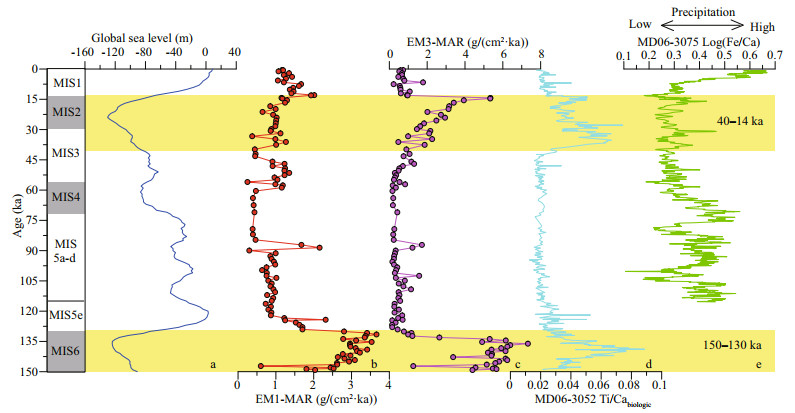
|
| Fig.11 Temporal variations of EM1 and EM3 detrital MARs in core MD06-3052 and the potential forcing mechanisms a. global sea level change (Spratt and Lisiecki, 2016); b. MAR of EM1 in core MD06-3052; c. MAR of EM3 in core MD06-3052; d. Ti/Cabiogenic ratio in core MD06-3052 (Xu et al., 2018); e. XRF core scanning record of log(Fe/Ca) in core MD06-3075 (Fraser et al., 2014). The yellow shaded area in the figure represents the two time periods of 150-130 ka and 40-14 ka. |
The input of detrital sediment in marginal seas may be influenced by sea-level changes, regional ocean currents and precipitation (Posamentier and Vail, 1988; Martinez et al., 2007; Steinke et al., 2008; Wu et al., 2013; Govin et al., 2014; Joussain et al., 2016). The Bicol Shelf is a transitional zone between the Philippine Islands and the western Philippine Sea Basin, and therefore the detrital sediment input to the area may be controlled by these factors. On the orbital time scale, these factors may have different degrees of influence on the different detrital end members. Due to the relatively flat terrain and shallow water of the inner portion of the Bicol Shelf, the input and deposition of island arc volcanic material may be significantly affected by sea-level changes. The variations of terrigenous proxies, such as Ti/Ca, TOC/TN, δ13Corg, and TA in core MD06-3054 from the Bicol Slope, indicate that detrital inputs during the Last Glacial Maximum (LGM) were significantly higher than that during the Holocene (Xiong et al., 2018). Xiong et al. (2018) argued that sea-level changes were responsible for long-term changes in island arc detrital inputs in the studied area since the LGM. The site of core MD06-3052 is located in a shallower water depth than core MD06-3054, and the contents of total detrital material and each grain-size end member, and the MAR of EM2 and EM3, in core MD06-3052 all increased significantly during glacial intervals with a low sea level (e.g. 150–130 ka, 40–14 ka) (Figs. 7 & 8); this is consistent with changes in terrestrial inputs indicated by Ti/Cabiogenic ratios (Fig. 11d, Xu et al., 2018). According to the global sea-level curve (Spratt and Lisiecki, 2016), sea level declined rapidly and rose during the two periods of 150–130 ka and 40– 14 ka, during which the average sea level was ~80 m lower than today (Fig. 11a). The site of core MD06-3052 was ~200 km from the east coast of Luzon Island during high sea-level stands but only ~70 km away from the coastline during low sea-level stands (the sea level was ~120 m lower than today during the LGM) (Xu et al., 2019). During this period, a large part of the Bicol Shelf was exposed, and the sediments on the exposed shelf became the main sediment source. The distance from the source to the sink greatly decreased, which resulted in the increased deposition of coarse-grained detritus (represented by EM2, EM3) in the study area. In addition, the large hydrodynamic forces generated by the rapid sea-level rise and fall during the low sea-level stand also enhanced the transport capacity and allowed more coarse sediments to be transported to the study area by gravity flows. This inference is consistent with the high sand content of the sediments during low sea-level stands (Fig. 5). Therefore, we conclude that the input of island arc materials to the Bicol Shelf was mainly controlled by sea-level change.
The variations in the MAR of EM1 during the two low sea-level stands (150–130 ka and 40–14 ka) are different, which may indicate that more complex mechanisms were responsible for the supply of EM1 to the Bicol Shelf. The significant increase in the MAR of EM1 during 150–130 ka is similar to that of EM2 and the MAR of EM3, corresponding to low sea-level stands, which indicates that sea level controlled the input of EM1 to the Bicol Shelf. However, the relatively low EM1 MAR during 40– 14 ka is different from that of EM2 and the MAR of EM3, which may indicate that different ocean current patterns influenced the supply of EM1 to the Bicol Shelf during these two low sea-level stands. However, due to lack of knowledge of ocean current patterns during these two periods, the influence of ocean currents on the distribution requires further study. In addition, the MAR of EM1 during the last 14 ka was slightly higher than that during the low sea-level stand of 40–14 ka, which is consistent with the rapid sea-level rise and the increased precipitation in the Philippine Islands (Fig. 11a & e). The increased rainfall would have strengthened weathering and erosion and increased the fluvial runoff in the Philippine Islands (Xiong et al., 2018; Xu et al., 2019). This process may have increased the sediment supply to the Bicol Shelf. More importantly, the rapid sea-level rise may have resulted in more vigorous sediment reworking by transgressive erosion, which may have resulted in more fine-grained sediments being supplied to the Bicol Shelf.
6 CONCLUSIONWe have studied the grain-size composition of detrital sediments, the radiogenic Sr and Nd isotopic composition of different grain-size fractions, and the MAR of detrital sediments in core MD06-3052 from the Bicol Shelf in western Philippine Sea in order to determine the sources and transport mechanisms of detrital sediments since 150 ka. Our main conclusions are as follows.
(1) Three end-members (EM1, EM2, and EM3 with respective modes at 2, 10, and 45 μm) were separated using parametric end-member analysis. The Sr and Nd isotopic compositions of the < 4 μm and > 20 μm detrital fractions indicate that the three end members in core MD06-3052 are mainly derived from the Philippine Islands.
(2) EM1 is mainly transported to the Bicol Shelf via surface currents; EM2 via bottom currents; and EM3 represents unconsolidated sediments exposed on the shelf during low sea-level stands, which were transported and re-deposited within the studied area by gravity flows.
(3) The content and MAR of the coarse detritus (EM2 and EM3) increased significantly during the glacial low sea-level stands since 150 ka, which indicates that sea-level change forced the supply of coarse detritus from the Philippine Islands to the Bicol Shelf. The fine-grained end member (EM1) in the Bicol Shelf is influenced not only by sea-level change, but also by ocean currents and regional precipitation.
7 DATA AVAILABILITY STATEMENTAll data generated and/or analyzed during this study are available from the corresponding author upon reasonable request.
8 ACKNOWLEDGMENTThe samples used in this study were collected by the "China-France" international cooperation cruise MD155-Marco Polo 2/IMAGES XIV. The authors thank all of the shipboard scientists and crew members of R/V Marion Dufresne. We also acknowledge WANG Hongli, ZHU Xiao, and ZHOU Ye for their help with grain-size measurements and data analysis. Finally, the authors wish to thank Dr. Richard Hiscott and another anonymous reviewer for thorough and constructive comments on the original manuscript, by which it was greatly improved.
Aurelio M A. 2000. Shear partitioning in the philippines:constraints from philippine fault and global positioning system data. Island Arc, 9(4): 584-597.
DOI:10.1046/j.1440-1738.2000.00304.x |
Bayon G, German C R, Boella R M, Milton J A, Taylor R N, Nesbitt R W. 2002. An improved method for extracting marine sediment fractions and its application to Sr and Nd isotopic analysis. Chemical Geology, 187(3-4): 179-199.
DOI:10.1016/S0009-2541(01)00416-8 |
Boulay S, Colin C, Trentesaux A et al. 2003. Mineralogy and Sedimentology of Pleistocene Sediment in the South China Sea (ODP Site 1144). In: Prell W L, Wang P X, Blum P, Rea D K, Clemens S C eds. Proceedings of the Ocean Drilling Program, Scientific Results, 184: 1-21, http://www-odp.tamu.edu/publications/184_SR/VOLUME/CHAPTERS/211.PDF.
|
Chen G C, Zheng H B, Li J R, Xie X, Mei X. 2008. Dynamic control on grain-size distribution of terrigenous sediments in the western South China Sea: Implication for East Asian monsoon evolution. Chinese Science Bulletin, 53(10): 1 533-1 543.
|
Chen J, Li G J, Yang J D, Rao W B, Lu H Y, Balsam W, Sun Y B, Ji J F. 2007. Nd and Sr isotopic characteristics of Chinese deserts: Implications for the provenances of Asian dust. Geochimica et Cosmochimica Acta, 71(15): 3 904-3 914.
DOI:10.1016/j.gca.2007.04.033 |
Chen Z, Li G J. 2013. Evolving sources of eolian detritus on the Chinese Loess Plateau since early Miocene: Tectonic and climatic controls. Earth and Planetary Science Letters, 371-372: 220-225.
DOI:10.1016/j.epsl.2013.03.044 |
Chi Y, Li A C, Jiang F Q, Wan S M. 2009. Assemblage and provenance of clay minerals off the east of Luzon Island. Marine Science, 33(9): 80-88.
(in Chinese with English abstract) |
Defant M J, Maury R C, Joron J L, Feigenson M D, Leterrier J, Bellon H, Jacques D, Richard M. 1990. The geochemistry and tectonic setting of the northern section of the luzon arc (the Philippines and Taiwan). Tectonophysics, 183(1-4): 187-205.
DOI:10.1016/0040-1951(90)90416-6 |
Feng J L, Zhu L P, Zhen X L, Hu Z G. 2009. Grain size effect on Sr and Nd isotopic compositions in eolian dust:Implications for tracing dust provenance and Nd model age. Geochemical Journal, 43(2): 123-131.
DOI:10.2343/geochemj.1.0007 |
Fine R A, Lukas R, Bingham F M, Warner M J, Gammon R H. 1994. The western equatorial Pacific: a water mass crossroads. Journal of Geophysical Research: Oceans, 99(C12): 25 063-25 080.
DOI:10.1029/94JC02277 |
Fraser N, Kuhnt W, Holbourn A, Bolliet T, Andersen N, Blanz T, Beaufort L. 2014. Precipitation variability within the West Pacific Warm Pool over the past 120 ka: Evidence from the Davao Gulf, southern Philippines. Paleoceanography and Paleoclimatology, 29(11): 1 094-1 110.
|
Gao S. 2009. Grain size trend analysis: principle and applicability. Acta Sedimentologica Sinica, 27(5): 826-836.
(in Chinese with English abstract) |
Goldstein S L, O'Nions R K, Hamilton P J. 1984. A Sm-Nd isotopic study of atmospheric dusts and particulates from major river systems. Earth and Planetary Science Letters, 70(2): 221-236.
|
Govin A, Chiessi C M, Zabel M, Sawakuchi A O, Heslop D, Hörner T, Zhang Y, Mulitza S, et al. 2014. Terrigenous input off northern South America driven by changes in Amazonian climate and the North Brazil Current retroflection during the last 250 ka. Climate of the Past, 10(2): 843-862.
DOI:10.5194/cp-10-843-2014 |
Gutjahr M, Frank M, Stirling C H, Klemm V, Van De Flierdt T, Halliday A N, et al. 2007. Reliable extraction of a deepwater trace metal isotope signal from Fe-Mn oxyhydroxide coatings of marine sediments. Chemical Geology, 242(3-4): 351-370.
DOI:10.1016/j.chemgeo.2007.03.021 |
Jacobsen S B, Wasserburg G J. 1984. Sm-Nd isotopic evolution of chondrites and achondrites, Ⅱ. Earth and Planetary Science Letters, 67(2): 137-150.
|
Jan Weltje G. 1997. End-member modeling of compositional data: numerical-statistical algorithms for solving the explicit mixing problem. Mathematical Geology, 29(4): 503-549.
DOI:10.1007/BF02775085 |
Jia Q, Li T G, Xiong Z F, Steinke S, Jiang F Q, Chang F M, Qin B B. 2018. Hydrological variability in the western tropical Pacific over the past 700 kyr and its linkage to Northern Hemisphere climatic change. Palaeogeography, Palaeoclimatology, Palaeoecology, 493: 44-54.
DOI:10.1016/j.palaeo.2017.12.039 |
Jiang F Q, Frank M, Li T G, Chen T Y, Xu Z K, Li A C. 2013. Asian dust input in the western Philippine Sea: evidence from radiogenic Sr and Nd isotopes. Geochemistry, Geophysics, Geosystems, 14(5): 1 538-1 551.
DOI:10.1002/ggge.20116 |
Jiang F Q, Zhou Y, Nan Q Y, Zhou Y, Zheng X F, Li T G, Li A C, Wang H L. 2016. Contribution of Asian dust and volcanic material to the western Philippine Sea over the last 220 kyr as inferred from grain size and Sr-Nd isotopes. Journal of Geophysical Research: Oceans, 121(9): 6 911-6 928.
DOI:10.1002/2016JC012000 |
Joussain R, Colin C, Liu Z F, Meynadier L, Fournier L, Fauquembergue K, Zaragosi S, Schmidt F, Rojas V, Bassinot F. 2016. Climatic control of sediment transport from the Himalayas to the proximal NE Bengal Fan during the last glacial-interglacial cycle. Quaternary Science Reviews, 148: 1-16.
DOI:10.1016/j.quascirev.2016.06.016 |
Kim Y Y, Qu T D, Jensen T, Miyama T, Mitsudera H, Kang H W, Ishida A, et al. 2004. Seasonal and interannual variations of the North Equatorial Current bifurcation in a high-resolution OGCM. Journal of Geophysical Research-Oceans, 109(C3): C03040.
DOI:10.1029/2003JC002013 |
Laj C, Balut Y, Wang P X, Kissel C, Holbourn A, Kienast M, Chen M T, Catane S, 2006. IMAGES XIV, MD155-Marco Polo 2 cruise report OCE/2006/06, In: Les rapports de campagnes à la mer, 55p., Institut Polaire Francais, Plouzané, France.
|
Li S, Yang S L, Liang M H, Cheng T, Chen H, Liu N N. 2018. The end member model analysis on grain size of loess in the eastern Tibetan Plateau. Earth and Environment, 46(4): 331-338.
(in Chinese with English abstract) |
Lisiecki R E, Raymo M E. 2005. A Pliocene-Pleistocene stack of 57 globally distributed benthic δ18O records. Paleoceanography and Paleoclimatology, 20(1): PA1003.
|
Liu H H, Jiang F Q, Zhou Y, Li A C. 2016. Provenance of clay minerals in the Amami Sankaku Basin and their paleoclimate implications since late Pleistocene. Advances in Earth Science, 31(3): 286-297.
(in Chinese with English abstract) |
Liu Z F, Zhao Y L, Colin C, Siringan F P, Wu Q. 2009. Chemical weathering in Luzon, Philippines from clay mineralogy and major-element geochemistry of river sediments. Applied Geochemistry, 24(11): 2 195-2 205.
DOI:10.1016/j.apgeochem.2009.09.025 |
Ma D D, Liu F, Zhu H L, Zhang Z F, Deng J H. 2018. Sr-NdPb-Ca isotopic compositions of the Cenozoic volcanic rocks in Manila, Philippines: Implication to deep carbon cycle during the subduction of South China Sea. Geochimica, 47(6): 593-603.
(in Chinese with English abstract) |
Martinez N C, Murray R W, Thunell R C, Peterson L C, Muller-Karger F, Astor Y, Varela R, et al. 2007. Modern climate forcing of terrigenous deposition in the tropics(Cariaco Basin, Venezuela). Earth and Planetary Science Letters, 264(3): 438-451.
|
McCave I N, Manighetti B, Robinson S G. 1995. Sortable silt and fine sediment size/composition slicing: Parameters for palaeocurrent speed and palaeoceanography. Paleoceanography and Paleoclimatology, 10(3): 593-610.
|
Milliman J D, Meade R H. 1983. World-wide delivery of river sediment to the oceans. The Journal of Geology, 91(1): 1-21.
|
Milliman J D, Syvitski J P M. 1992. Geomorphic tectonic control of sediment discharge to the ocean: the importance of small mountainous rivers. The Journal of Geology, 100(5): 525-544.
DOI:10.1086/629606 |
Mukasa S B, Flower M F J, Miklius A. 1994. The Nd-, Sr- and Pb-isotopic character of lavas from Taal, Laguna de Bay and Arayat volcanoes, southwestern Luzon, philippines:implications for arc magma petrogenesis. Tectonophysics, 235(1-2): 205-221.
DOI:10.1016/0040-1951(94)90024-8 |
Paterson G A, Heslop D. 2015. New methods for unmixing sediment grain size data. Geochemistry Geophysics Geosystems, 16(12): 4 494-4 506.
DOI:10.1002/2015GC006070 |
Pettke T, Halliday A N, Hall C M, Rea D K. 2000. Dust production and deposition in Asia and the north Pacific Ocean over the past 12 Myr. Earth and Planetary Science Letters, 178(3-4): 397-413.
DOI:10.1016/S0012-821X(00)00083-2 |
Posamentier H W, Vail P R. 1988. Eustatic controls on clastic deposition Ⅱ-sequence and systems tract models. In: Wilgus C K, Hastings B S, Kendall C G St C, et al eds.Sea-Level Changes-An Integrated Approach. SEPM Special Publication, New York, 42: 125-154.
|
Qiu B, Lukas R. 1996. Seasonal and interannual variability of the North Equatorial Current, the Mindanao Current, and the Kuroshio along the Pacific western boundary. Journal of Geophysical Research: Oceans, 101(C5): 12 315-12 330.
DOI:10.1029/95JC03204 |
Qiu X H. 2013. The Paleoceanographic Records during the Past 150 kyr B.P. in the Northern Part of Western Pacific Warm Pool. University of Chinese Academy of Sciences, Beijing, China. 113p.
(in Chinese with English abstract)
|
Qu T D, Lukas R. 2003. The bifurcation of the North Equatorial Current in the Pacific. Journal of Physical Oceanography, 33(1): 5-18.
DOI:10.1175/1520-0485(2003)033<0005:TBOTNE>2.0.CO;2 |
Shchepetkin A F, McWilliams J C. 2005. The regional oceanic modeling system (ROMS): a split-explicit, free-surface, topography-following-coordinate oceanic model. Ocean Modelling, 9(4): 347-404.
DOI:10.1016/j.ocemod.2004.08.002 |
Skinner L C, McCave I N. 2003. Analysis and modelling of gravity- and piston coring based on soil mechanics. Marine Geology, 199(1-2): 181-204.
DOI:10.1016/S0025-3227(03)00127-0 |
Spratt R M, Lisiecki L E. 2016. A late pleistocene sea level stack. Climate of the Past, 12(4): 1 079-1 092.
DOI:10.5194/cp-12-1079-2016 |
Steinke S, Hanebuth T J J, Vogt C, Stattegger K. 2008. Sea level induced variations in clay mineral composition in the southwestern South China Sea over the past 17, 000 yr. Marine Geology, 250(3-4): 199-210.
DOI:10.1016/j.margeo.2008.01.005 |
Sun D H, Bloemendal J, Rea D K, Vandenberghe J, Jiang F C, An Z S, Su R X. 2002. Grain-size distribution function of polymodal sediments in hydraulic and aeolian environments, and numerical partitioning of the sedimentary components. Sedimentary Geology, 152(3-4): 263-277.
DOI:10.1016/S0037-0738(02)00082-9 |
Sun J M. 2005. Nd and Sr isotopic variations in Chinese eolian deposits during the past 8 Ma: Implications for provenance change. Earth and Planetary Science Letters, 240(2): 454-466.
|
Sun Y B, Gao S, Li J. 2003. Preliminary analysis of grain-size populations with environmentally sensitive terrigenous components in marginal sea setting. Chinese Science Bulletin, 48(2): 184-187.
DOI:10.1360/03tb9038 |
Széréméta N, Bassinot F, Balut Y, Labeyrie L, Pagel M. 2004. Oversampling of sedimentary series collected by giant piston corer: Evidence and corrections based on 3.5-kHz chirp profiles. Paleoceanography and Paleoclimatology, 19(1): PA1005.
|
Walter H J, Hegner E, Diekmann B, Kuhn G, Van Der Loeff M M R. 2000. Provenance and transport of terrigenous sediment in the South Atlantic Ocean and their relations to glacial and interglacial cycles: Nd and Sr isotopic evidence. Geochimica et Cosmochimica Acta, 64(22): 3 813-3 827.
DOI:10.1016/S0016-7037(00)00476-2 |
Wan S M, Yu Z J, Clift P D, Sun H J, Li A C, Li T G. 2012. History of Asian eolian input to the West Philippine Sea over the last one million years. Palaeogeography, Palaeoclimatology, Palaeoecology, 326-328: 152-159.
DOI:10.1016/j.palaeo.2012.02.015 |
Wang Y X, Yang J D, Chen J, Zhang K J, Rao W B. 2007. The Sr and Nd isotopic variations of the Chinese Loess Plateau during the past 7 Ma: Implications for the East Asian winter monsoon and source areas of loess. Palaeogeography, Palaeoclimatology, Palaeoecology, 249(3-4): 351-361.
DOI:10.1016/j.palaeo.2007.02.010 |
Wu J W, Liu Z F, Zhou C. 2013. Provenance and supply of Feenriched terrigenous sediments in the western equatorial Pacific and their relation to precipitation variations during the late Quaternary. Global and Planetary Change, 108: 56-71.
DOI:10.1016/j.gloplacha.2013.06.002 |
Xie L L, Tian J W, Hu D X, Wang F. 2009. A quasi-synoptic interpretation of water mass distribution and circulation in the western North Pacific Ⅱ: Circulation. Chinese Journal of Oceanology and Limnology, 27(4): 955-965.
DOI:10.1007/s00343-009-9240-x |
Xiong Z F, Li T G, Chang F M, Algeo T J, Clift P D, Bretschneider L, Lu Z Y, Zhu X, Frank M, Sauer P E, Jiang F Q, Wan S M, Zhang X, Chen S X, Huang J. 2018. Rapid precipitation changes in the tropical West Pacific linked to North Atlantic climate forcing during the last deglaciation. Quaternary Science Reviews, 197: 288-306.
DOI:10.1016/j.quascirev.2018.07.040 |
Xu Z K, Li T G, Clift P D, Lim D, Wan S M, Chen H J, Tang Z, Jiang F Q, Xiong Z F. 2015. Quantitative estimates of Asian dust input to the western Philippine Sea in the midlate Quaternary and its potential significance for paleoenvironment. Geochemistry, Geophysics, Geosystems, 16(9): 3 182-3 196.
DOI:10.1002/2015GC005929 |
Xu Z K, Li T G, Clift P D, Wan S M, Lim D, Chang F M, Sun R T. 2019. Sea-level, monsoonal, and anthropogenic impacts on the millennial-scale variability of siliciclastic sediment input into the western Philippine sea since 27 ka. Journal of Asian Earth Sciences, 177: 250-262.
DOI:10.1016/j.jseaes.2019.04.001 |
Xu Z K, Li T G, Clift P D, Wan S M, Qiu X H, Lim D. 2018. Bathyal records of enhanced silicate erosion and weathering on the exposed Luzon shelf during glacial lowstands and their significance for atmospheric CO2 sink. Chemical Geology, 476: 302-315.
DOI:10.1016/j.chemgeo.2017.11.027 |
Xu Z K, Li T G, Wan S M, Nan Q Y, Li A C, Chang F M, Jiang F Q, Tang Z. 2012. Evolution of East Asian monsoon:Clay mineral evidence in the western Philippine Sea over the past 700 kyr. Journal of Asian Earth Sciences, 60: 188-196.
DOI:10.1016/j.jseaes.2012.08.018 |
Xu Z K, Li T G, Wan S M, Yin X B, Jiang F Q, Sun H J, Choi J, Lim D. 2014. Geochemistry of rare earth elements in the mid-late Quaternary sediments of the western Philippine Sea and their paleoenvironmental significance. Science China Earth Sciences, 57(4): 802-812.
DOI:10.1007/s11430-013-4786-z |
Yang D Z, Yin B S, Chai F, Feng X R, Xue H J, Gao G D, Yu F. 2018. The onshore intrusion of Kuroshio subsurface water from February to July and a mechanism for the intrusion variation. Progress in Oceanography, 167: 97-115.
DOI:10.1016/j.pocean.2018.08.004 |
Yu Z J, Wan S M, Colin C, Song L N, Zhao D B, Huang J, Sun H J, Xu Z K, Li A C, Li T G. 2018. ENSO-like modulated tropical pacific climate changes since 2.36 Myr and its implication for the middle Pleistocene transition. Geochemistry, Geophysics, Geosystems, 19(2): 415-426.
DOI:10.1002/2017GC007247 |
Yu Z J, Wan S M, Colin C, Yan H, Bonneau L, Liu Z F, Song L N, Sun H J, Xu Z K, Jiang X J, Li A C, Li T G. 2016. Coevolution of monsoonal precipitation in East Asia and the tropical Pacific ENSO system since 2.36 Ma: New insights from high-resolution clay mineral records in the West Philippine Sea. Earth and Planetary Science Letters, 446: 45-55.
DOI:10.1016/j.epsl.2016.04.022 |
Yu Z J, Wan S M, Sun H J, Huang J, Xu Z K, Li C A, Li T G. 2012. Grain-size records of Asian eolian input to the West Philippine Sea over the last one million years. Journal of Earth Environment, 3(2): 792-800.
(in Chinese with English abstract) |
Zhou Y, Jiang F Q, Nan Q Y, Liu H H, Li A C. 2016. Grain-size distribution of detrital sediment in the Amami Sankaku Basin since late Pleistocene and its provenance and palaeoclimate implications. Advances in Earth Science, 31(3): 298-309.
(in Chinese with English abstract) |
 2020, Vol. 38
2020, Vol. 38


